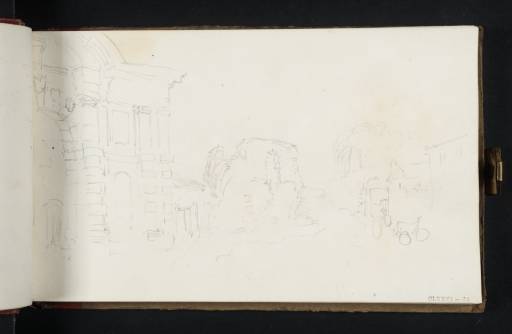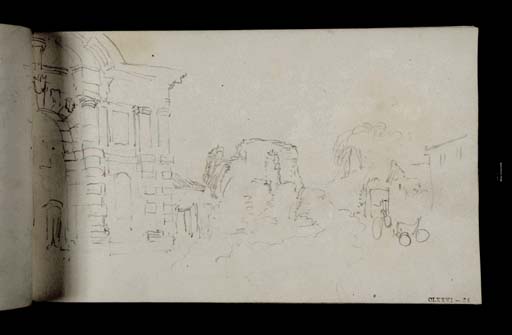Joseph Mallord William Turner The Porta Galliera, Bologna 1819
Image 1 of 2
Joseph Mallord William Turner,
The Porta Galliera, Bologna
1819
Joseph Mallord William Turner 1775–1851
Folio 24 Recto:
The Porta Galliera, Bologna 1819
D14532
Turner Bequest CLXXVI 24
Turner Bequest CLXXVI 24
Pencil on white wove paper, 111 x 184 mm
Inscribed by John Ruskin in red ink ‘24’ bottom right (now faint)
Stamped in black ‘CLXXVI – 24’ bottom right
Inscribed by John Ruskin in red ink ‘24’ bottom right (now faint)
Stamped in black ‘CLXXVI – 24’ bottom right
Accepted by the nation as part of the Turner Bequest 1856
References
1909
A.J. Finberg, A Complete Inventory of the Drawings of the Turner Bequest, London 1909, vol.I, p.517, CLXXVI 24, as ‘A gateway’.
1984
Cecilia Powell, ‘Turner on Classic Ground: His Visits to Central and Southern Italy and Related Paintings and Drawings’, unpublished Ph.D thesis, Courtauld Institute of Art, University of London 1984, pp.82, 406, as ‘Porta Galliera, Bologna’, 462 note 62.
1987
Cecilia Powell, Turner in the South: Rome, Naples, Florence, New Haven and London 1987, pp.24, 202 note 39.
The inner side of Bologna’s imposing Baroque Porta Galleria is shown from the south-west, marking the northern approach to the city by the road from Ferrara. Cecilia Powell and James Hamilton have both observed how very few sketches Turner made after leaving Venice (folios 21 verso–24 recto; D14528–D14532; also folio 90 verso; D14652; Turner Bequest CLXXVI 86a) until his arrival at Bologna here; see under D14528.1
The gateway now stands in the Piazza XX Settembre, near the ruined section of the city wall shown by Turner, which is a little further off than his drawing might suggest, across the Rampa Maggiore Leopoldo Serra. Presumably because of his low viewpoint, Turner omitted the elements above the heavily rusticated structure’s entablature and segmental pediment, comprising a central pilastered and pedimented attic storey flanked by elaborate pyramidal finials.
The line of the main arch is continued briefly on folio 23 verso opposite (D40896). The pages between here and folio 42 verso (D14532–D14565; Turner Bequest CLXXVI 24–42 verso; see also folios 83 recto and 90 verso; D14641, D14652; CLXXVI 79, 86a) make up an extensive survey of the city of Bologna and its hilly surroundings,2 although a few of the slighter views are difficult to place; folio 28 verso in particular (D14537; Turner Bequest CLXXVI 26c) may represent somewhere else, while folio 37 verso (D14555; Turner Bequest CLXXVI 33a) appears to be labelled ‘Imola’, which lies about twenty miles to the east.
By Turner’s time fewer than a quarter of over a hundred vertiginous towers which had been such a characteristic of medieval Bologna remained,3 shown here among various Renaissance and Baroque buildings; the city walls then enclosing the centre did not survive beyond the turn of the twentieth century, although various other substantial gateways still mark the perimeter.4 Bologna’s extensive arcades or porticoes5 appear in numerous drawings, particularly the remarkable free-standing structure leading out of the city up the hill to the Sanctuary of the Madonna di San Luca, which Turner also visited.
Important artists of the Bolognese School had included the Carraccis in the late sixteenth century and Domenichino and Guido Reni in the early seventeenth. Powell has noted the established English taste for such artists, although in Turner’s case ‘there is no evidence in the sketchbooks as to which ones he looked at while he was there’ except by inference from a topographical sketch made in the neighbourhood of the city’s Accademia and a note of an Italian phrase likely seeking directions to it; see folios 31 recto and 90 recto respectively (D14543, D14651; Turner Bequest CLXXVI 27, 86).6
From Bologna the artist turned south-east towards the coast and Ancona (see under folio 69 verso; D14614; Tuner Bequest CLXXVI 65a) on his zigzag route southwards to Rome. His homeward journey early in 1820 saw him pass through Bologna again, but the next drawings were made on his 1828–9 Italian tour, in the Rimini to Rome sketchbook (Tate D14861–D14862, D14870–D14871, D14876; Turner Bequest CLXXVIII 16a, 17, 21a, 22, 24a). See under D14641 in this book for two slight watercolour studies of the city from the 1820s.
See James Hamilton, ‘Turner e l’Italia’ in Hamilton, Nicola Moorby, Christopher Baker and others, Turner e l’Italia, exhibition catalogue, Palazzo dei Diamanti, Ferrara 2008, p.43, and James Hamilton, ‘Turner’s Route to Rome’ in Hamilton, Nicola Moorby, Christopher Baker and others, Turner & Italy, exhibition catalogue, National Galleries of Scotland, Edinburgh 2009, p.42.
See ‘Bologna Towers Tour’, Bologna Welcome, accessed 12 March 2017, http://www.bolognawelcome.com/en/home/discover/itineraries/culture/bologna-towers-tour/ .
See ‘City Gates’, ibid., accessed 12 March 2017, http://www.bolognawelcome.com/en/home/discover/itineraries/culture/city-gates/ .
See ‘The Porticoes of Bologna’, ibid., accessed 12 March 2017, http://www.bolognawelcome.com/en/home/discover/itineraries/culture/the-porticoes-of-bologna/ .
Technical notes:
There are yellowish stains, which have saturated the previous two leaves as well as apparently being offset on folio 21 verso (D14528) before fading off here.
Verso:
Blank
Matthew Imms
March 2017
How to cite
Matthew Imms, ‘The Porta Galliera, Bologna 1819 by Joseph Mallord William Turner’, catalogue entry, March 2017, in David Blayney Brown (ed.), J.M.W. Turner: Sketchbooks, Drawings and Watercolours, Tate Research Publication, July 2017, https://www


